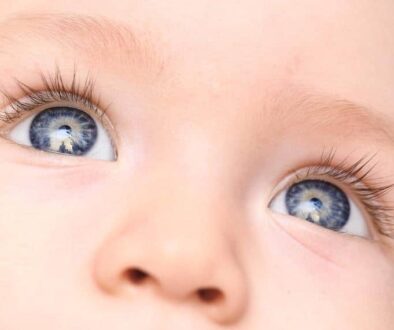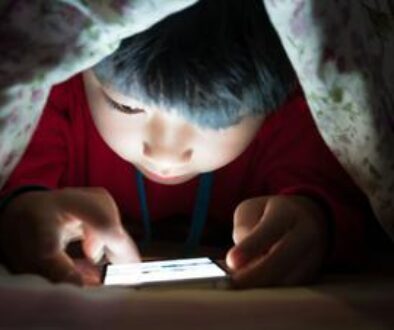Protect Kids Vision: Myopia & Screen Habits Guide
Protect your child’s vision: Learn how close-screen habits and myopia can impact eye health, and discover steps to reduce progression and improve clarity.
Key Takeaways:
- Myopia (nearsightedness) is common in children and can cause blurry distance vision, leading them to sit closer to screens to see more clearly.
- 41.9% of children in the U.S. are myopic, and myopia progresses over time.
- Near work activities like reading, using computers, and screen time can speed up myopia progression.
- Accommodation strain increases when objects are viewed up close, leading to more eye fatigue and less relaxation, especially when alternating between tasks like reading and screen time.
- Outdoor play helps reduce myopia progression, as it limits time spent on near work and allows eyes to relax.
- 20/20/2 Rule: Every 20 minutes of near work, look 20 feet away for 2 minutes to relieve eye strain.
- Pediatric eye exams are essential to detect myopia early, with exams recommended at 6-12 months, 3-5 years, before school, and annually after.
- Myopia management includes options like eye drops, soft contact lenses, and Ortho-K to slow progression. Consult your eye doctor to discuss these options.
Don’t sit so close to the TV (or computer, or tablet, or cellphone)
It is a phrase that many people have heard a parent say before, but may not understand completely. The importance of how close we look at objects cannot be stressed enough in young children.
Your child may want to sit close to the TV (or other objects) if they have uncorrected nearsightedness (or myopia). Myopia means your eyes naturally focus in front of you leading to blurry distance vision. Therefore kids may be moving closer to the TV in order to clear up the image by finding their natural focal point.
Why is this important?
- The most important idea to realize is your child may need correction (glasses or contacts) to see clearly at all distances
- Research has shown 41.9% of children in the U.S. are myopic and myopia is progressive in nature
- Increased near work including computers, reading, cellphones, and tablets has been proven to speed up this progression of myopia.
What does science tell us about our working distance?
In general, the closer an object is to us, the more accommodation or “work” our eyes have to do. A recent study published shows how much more work our eyes have to do when looking at a paper compared to viewing trees outside (See Figure 1). You can see the significant difference in accommodation on the right side when looking outdoors compared to reading a document. If children are working all day at a desk alternating between computer and paperwork, their eyes never get a chance to fully relax.

Figure 1: The first column on the left shows some images we regularly see. The second column in the middle correlates the intensity of light to the distance from our eye (the brighter light the greater the distance). The third column on the right transforms the distance into Diopters (or the measurement of how much accommodation your eyes are doing). Reference

Figure 2. Recommendations on screen time from the American Academy of Pediatrics.
Why Age Matters in Screen Habits
Young eyes are still developing, making them more vulnerable to excessive screen time and prolonged close-up device use. Recent studies confirm that myopia (nearsightedness) affects over 40% of U.S. children, with rates climbing rapidly. Early and heavy screen exposure significantly increases the risk of severe, progressive myopia.
Age-Based Screen Time Guidelines
Protect your child’s vision with these age-specific screen time recommendations, endorsed by pediatric optometrists in Tamarac, FL:
-
Ages 0–2: Avoid screens except for brief video calls.
-
Ages 2–5: Limit to 1 hour/day of educational, interactive content.
-
Ages 6+: Restrict recreational screens to 2 hours/day (beyond schoolwork). Always pair with the 20-20-20 rule (20-second break every 20 minutes) and daily outdoor play.
Practical Tips for Tamarac Parents
-
Use tools: Activate parental controls (iOS/Android) and device timers.
-
Create tech-free zones: Prioritize screen-free meals and family time.
-
Lead by example: Demonstrate balanced screen habits—kids mirror adult behavior.
Digital Learning’s Impact on Young Eyes
Nearly 94% of children’s screen time now stems from virtual classrooms and homework, making digital education a primary driver of eye strain and myopia risk in Tamarac, FL. Extended close-up screen exposure often triggers Computer Vision Syndrome (CVS) – marked by dry eyes, headaches, and blurred vision.
Vision-Safe Study Spaces: Tamarac Tips
Create healthier digital classrooms at home with these optometrist-backed strategies:
-
Lighting: Position desks perpendicular to windows to maximize South Florida’s natural light while minimizing glare.
-
Distance: Keep screens 20–24 inches from eyes (arm’s length).
-
Ergonomics: Align monitor tops at eye level to prevent neck/eye strain.
Healthy Screen Routines for FL Students
Combat digital eye strain with science-backed habits:
-
20/20/2 Rule: Every 20 minutes, pause for 2 minutes to focus 20+ feet away.
-
Movement Breaks: Stretch or snack between virtual lessons (no screens!).
- Outdoor Balance: 1–2 hours of daily outdoor play – crucial for offsetting near-work myopia risks.
What should I do now?
There are a few habits that parents can adopt to help protect their child’s eyes:
- Get outside and play – limit screen time as recommended by the American Academy of Pediatrics. This can help reduce the amount of work your eyes have to do and reduce the stimulus for progression of myopia
- “20/20/2 Rule” – Take frequent breaks when doing any near work for extended periods of time. Every 20 minutes, look 20 feet away for around 2 minutes. This will allow your eyes to relax their accommodation, allow you to blink, reset your posture and return to work with less strain on your visual system.
- Find out if your child is myopic – it is best to find out early if myopia is present to act quickly to try to reduce progression. Make sure children have pediatric eye exams at 6-12 months, 3-5 years, before starting school and every year after as recommended by the American Optometric Association Clinical guidelines.
- Discuss myopia management with your eye doctor – there are many techniques to reduce progression of myopia including eye drops, soft contact lenses, and Ortho-K.
Why Do Kids Sit So Close to Screens? Understanding the Myopia Connection
Kids sitting closer to screens isn’t always just a harmless habit. In many cases, it reveals a vision problem known as myopia, or nearsightedness. If your child’s eyesight is blurry at distance, they’ll instinctively move closer to clear the picture. While genetics can play a role, studies confirm that excessive close-up activities like screen time significantly increase myopia progression.
Early Symptoms of Vision Issues in Children
To protect your child’s eyes effectively, watch for these common signs of developing myopia:
- Frequent squinting or rubbing of eyes
- Complaints about headaches or blurry vision
- Moving closer to screens or books
- Trouble seeing distant objects clearly
Noticing these early can help you intervene quickly, potentially slowing myopia progression before it becomes severe.
How Does Screen Distance Affect Vision Health?
Eye Accommodation and the Impact of Close Viewing
When children stare at screens too close, their eyes constantly strain to maintain focus. This constant strain, known as “eye accommodation,” causes eye fatigue, headaches, and blurred vision—symptoms collectively known as Computer Vision Syndrome (CVS). Over time, prolonged close-up viewing significantly accelerates myopia progression.
Ideal Screen Distances for Kids (Recommended by Experts)
Setting appropriate viewing distances can dramatically reduce eye strain:
- TV screens: At least 6–8 feet away
- Computer monitors: 20–24 inches away
- Tablets & smartphones: 16–18 inches away
Following these guidelines, suggested by the American Optometric Association, helps minimize strain and lowers the risk of myopia development.
Recognizing and Preventing Computer Eye Strain (CVS)
Common Symptoms of CVS in Children
Computer Vision Syndrome often goes unnoticed because symptoms seem minor or unrelated. Watch for these warning signs:
- Headaches during or after screen time
- Dry, itchy, or watery eyes
- Sensitivity to light or glare
- Difficulty concentrating
Easy Steps to Reduce Computer Eye Strain
Implement these simple tips to protect your child’s vision from CVS:
- Use the 20/20/2 Rule: Every 20 minutes, encourage your child to look at something 20 feet away for at least 2 minutes.
- Optimize Room Lighting: Avoid screen glare by keeping lights dim and indirect.
- Adjust Screen Settings: Maintain medium brightness and contrast; use blue-light filters when available.
How Near Work Speeds Up Myopia Progression
Scientific research clearly demonstrates that prolonged “near work,” like extensive screen use or reading at close distances, significantly accelerates myopia. A child’s eyeball may elongate from constant close-up focusing, making distant objects increasingly blurry.
The Surprising Benefits of Outdoor Activity
Encouraging outdoor play has proven benefits in slowing down myopia progression. Regular exposure to natural daylight helps regulate healthy eye growth, reducing the risk of severe nearsightedness. Aim for at least 1–2 hours of outdoor play daily.
Practical Myopia Management Strategies
When myopia appears, management strategies can slow or halt its progression effectively. Here are the most recommended methods:
- Prescription Eye Drops: Low-dose atropine drops significantly slow eye growth.
- Specialized Contact Lenses: Multifocal soft lenses and Orthokeratology (Ortho-K) reshape the cornea and improve distance vision, helping reduce myopia progression.
- Regular Pediatric Eye Exams: Annual eye exams help identify and address vision problems promptly.
Consult your optometrist to choose the best method based on your child’s individual needs.
The Importance of Regular Eye Exams for Kids
When to Schedule Pediatric Eye Exams
Early vision screenings are crucial. The American Optometric Association recommends pediatric eye exams at:
- 6–12 months old
- 3–5 years old
- Annually after beginning school
What to Expect During an Eye Exam
During a pediatric exam, your child’s eye doctor checks visual acuity, eye alignment, refractive errors, and overall eye health. Early detection makes treatment easier and more effective.
Debunking Common Myths About Kids’ Vision
Myth: Sitting Close to Screens Permanently Damages Vision
Reality: Sitting close doesn’t directly damage eyesight. It’s usually an indication of existing myopia, making a professional eye exam necessary.
Myth: Glasses Worsen Your Child’s Vision
Reality: Proper glasses help eyes relax, improving comfort and preventing further eye strain. They don’t cause vision deterioration.
Quick Tips for Parents: Protecting Kids from Eye Strain and Myopia
- Encourage proper screen viewing distances (16–24 inches for handheld devices).
- Follow the 20/20/2 rule consistently.
- Limit recreational screen time and ensure outdoor activity.
- Schedule regular eye exams to catch vision changes early.
Contact your eye doctor today if you want to discuss myopia and myopia control – make an appointment today online or call our office.
FAQs
-
Children may sit close to the TV due to uncorrected nearsightedness (myopia). Their eyes naturally focus closer, making distant objects blurry. Sitting near the screen helps them see clearly. Schedule a pediatric eye exam at West Broward Eye Care in Tamarac, FL, to check for myopia.





